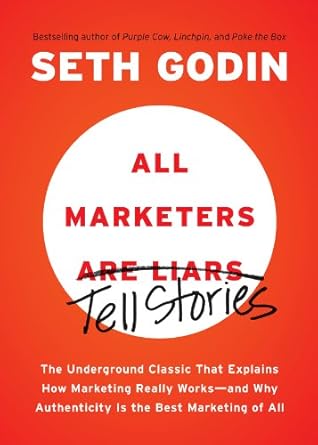More on this book
Community
Kindle Notes & Highlights
by
Seth Godin
Read between
April 11 - June 16, 2017
We believe what we want to believe, and once we believe something, it becomes a self-fulfilling truth.
“What’s your story?” “Will the people who need to hear this story believe it?” “Is it true?”
All marketers are storytellers. Only the losers are liars.
Marketers didn’t invent storytelling. They just perfected it.
People can’t handle the truth.
no one buys facts. They buy a story.
The facts are irrelevant. In the short run, it doesn’t matter one bit whether something is actually better or faster or more efficient. What matters is what the consumer believes.
Needs are practical and objective, wants are irrational and subjective.
the path to profitable growth is in satisfying wants, not needs.
Truly great stories succeed because they are able to capture the imagination of large or important audiences.
A great story is true.
Great stories make a promise.
Great stories are trusted.
no marketer succeeds in telling a story unless he has earned the credibility to tell that story.
Great stories are subtle.
Great stories happen fast.
Great stories don’t appeal to logic, but they often appeal to our senses.
Great stories are rarely aimed at everyone.
Great stories don’t contradict themselves.
And most of all, great stories agree with our worldview.
Successful marketers are just the providers of stories that consumers choose to believe.
marketing is the most powerful force available to people who want to make change.
Marketing is about spreading ideas, and spreading ideas is the single most important output of our civilization.
Marketing is the story marketers tell to consumers, and then maybe, if the marketer has done a good job, the lie consumers tell themselves and their friends.
no marketing succeeds if it can’t find an audience that already wants to believe the story being told.
Everyone will not listen to everything.
Some people will hear part of your message and make an assumption about what your product does. Other people will ignore that part and instead focus on the way your logo makes them feel. And a third group will ignore all that and just look at the price.
We’d like to believe that people are rational and informed. They are neither.
The reason marketing seems irrational and inconsistent and faddy is that it is.
That doesn’t make it safe, but it seems to keep it interesting.
There are only two things that separate success from failure in most organizations today: 1. Invent stuff worth talking about. 2. Tell stories about what you’ve invented. Make up great stories. That’s the new motto.
it’s easier than it’s ever been to get something made, shipped and stocked.
being good enough at manufacturing isn’t good enough anymore.)
your résumé should be about inventing remarkable things and telling stories that register—not about how good you are at meeting specs. Organizations that are going to be around tomorrow will be those that stop spending all their time dealing with the day-to-day crises of shipping stuff out the door or reacting to emergencies.
if we all want the same thing, why do we take so many opposite tacks to get there?
The great failure of marketing theory is its inability to explain variety.
It turns out that we don’t all want the same things!
The lens your consumers use shows them a different version of reality than it shows you or your colleagues or your other customers.
Different people, different worldviews. People can see the same data and make a totally different decision.
Don’t try to change someone’s worldview is the strategy smart marketers follow.
identify a population with a certain worldview, frame your story in terms of that worldview and you win.
it’s awfully dangerous to assume that consumers are all the same—it’s even dangerous to assume that they’re all rational.
A vote is a statement about the voter, not the candidate.
Marketing succeeds when enough people with similar worldviews come together in a way that allows marketers to reach them cost-effectively.
while changing a worldview is fairly glamorous work, it doesn’t often lead to a lot of profit.
Your opportunity lies in finding a neglected worldview, framing your story in a way that this audience will focus on and going from there.
We are not all the same. The mass market is dead.
We may all be created equal, but our worldviews are different.
A worldview is not who you are. It’s what you believe. It’s your biases. A worldview is not forever. It’s what the consumer believes right now.
Often a shared worldview is not an entire market, just part of one—


